QuestionQUESTION: Hi. I am an animal control officer and picked up a bearded dragon yesterday afternoon that was found as a stray. I have no idea how long it was outside. P.M. temps have been around 50 degr. or so and recently between 65 - 85 daytime temp. and it rained the day before. The dragon is approx. 14 in long and seems thin to me, but I don't know that much about them. I went out and purchased some crickets and veggies for him - kale, parsley, collard, and dandelion greens. I made sure everything is in small pieces for it, and the crickets, as I read, are smalled than the space between his eyes. I placed a lamp (reg. bulb) over his cage (currently too small for him on a perm. basis...) to warm him up. He's been basking on a branch I gave him under the bulb since, but shows no interest in the food at all, so am not sure if this is stress, illness or both. Its been moving around a bit but only with stimulation. I also think it has mites, since it makes me itch madly everytime I touch it and I feel like something is crawling on me. Any advice for the short term? I don't want to spend a fortune on it until an owner has time to claim it, but want to be able to tell if it needs urgent medical care or not or if its anorexia is normal at this point. Any est. as to age at this length as well? It is alternating between light and dark brownish color as well. I've read the care sheet that has been provided, but am hoping you might be able to tell me what to do for a beardie in such a stressful situation. Since its Sun, no vets are open right now (though I do also work full time as a vet tech, not in a practice that handles exotics). Any suggestions about the mite problem?
Many thanks
ANSWER: Hi Sue,
I've included a basic care sheet for you on the bearded dragon.I know you said you read it, but this will save you having to go to other links to read it again.
Mites are tiny little specs of red, brown or black, usually seen in the more tender spots on the reptile...areas like in the creases of the legs, around the eyes,ears..... and also around the subtympanic scale and dewlap of iguanas.
Mites have a life cycle that just keeps repeating itself if the correct steps are not taken to destroy all stages of them including the eggs. What's important is identifying the mites on your reptile.....you WILL be able to see them somewhere on them, if they do have them. You may need to use a magnifying glass...Do not treat for mites unless you see them!!!
Unfortunately mite can come in any of the substrates such as lizard litter from pet stores. Bark substrates are one of the worst products for harboring mites. The mites get into the product (or are in the product at manufacture time) or even other items that we buy such as dishes,branches and even the feeder foods such as mice that are purchased for snakes. If there are mites on the pet store reptiles, there most likely are mites in other parts of the store due to mites being able to travel for a short distance. They can "come home" on your clothes from the stores, shows and visiting someone who has reptile mites. Getting branches from around the home and not baking them at 200-250 degrees for 2-3 hours or soaking them (in a bleach solutions of 1 cup bleach to a gallon of water, then rinsing well with HOT water and drying in the sun)
Not only does the reptile need treated, the cage, all the caves, dishes, branches and anything else in the cage needs done as does the surrounding area. Also any other reptiles in the home. Remember..the mites can travel on us from area to area.
One treatment does not remove the mites. Many times it takes several treatments of ALL areas, including the reptile.. Just be sure to follow all label or recommended applications as that if they are not followed, death can occur to the reptile. Unfortunately there are no short cuts or easy steps in getting rid of mites.
To post all the ways to treat and what steps to take,would be a book in itself so below is a link in which you can go to, read and print out to have it handy and follow the recommendations for the cleaning of ALL items and preventive measures.
I had gotten in two rescue iguanas that had a heavy infestation of mites. It was my first experience with them, and I sure hope it was my last!!! For this I used a product called
"Reptile Relief" made by "Natural Chemistry". Its all natural and very safe. http://www.naturalchemistry.com/ I actually picked mine up at PetsMart. It does recommend more than one treatment as I think most products do.
If by some odd chance you don't have good results with the above product, there is a good article on mite and why they are hard to kill at http://www.anapsid.org/mites.html Also, the risks of certain treatments are discussed. This list of risks is extremely handy to know if you do take your reptiles to the vet for treatment, which sometimes is needed, especially if there is damage to the reptile from mite bites which are visible as raised and or missing scales and/or irritated areas. With this, there may be a need for oral antibiotics prescribed by a vet to prevent infections.
Be sure to read the above link and follow all instructions with treatments and products. There are no shortcuts for getting rid of the pesky little bugs.
Temperature wise, beardies can handle a lower temperature on occasion...so that should not really be a problem if there was nice sunshine.
Its hard to actually tell his age as that "pet store" dragons don't generally grow as large as a healthy private breeder one. Chances are its an adult...over a year of age..or it can be a younger one...just no way to tell.
Its normal that he wont eat right now..reptiles stress very easily. The color changes can be his normal colors...the dark can occur when he is trying to absorb more heat. Right now, proper basking temperatures and hydration are important. Mist him with a spray bottle ..hopefully he will drink. You can also bathe him...which will also tell you if there are really mites there. Some will most likely come off in the water.. With the low temperatures he had(although not deadly to them) he has deminished gut bacteria.. Once he warms up properly he should show some interest in food.
The chances of the dragon having had all the proper care before you found it are slim to none. MOST owners that know nothing about the dragons don't even offer the greens to them and feed only crickets or mealworms. Don't count on someone claiming him either...people many times tire of their reptiles and think its fine to just rrelease them into the wild...
If he is basking, thats a good sign... If he is lethargic then his condition can be a bit more serious...but..as I said the basking part is great!
As I said, correct temperatures and hydration are important right now...do offer the crickets or if you are able to get some wax worms, offer him a few of those. Although not a diet for every day, it may entice him to eat. As with other animals, sometimes their gut bacteria becomes depleted from lack of food and stress...bene bac works to replace the bacteria needed. Also, when reptiles become stressed, they cana develop an internal parasite overload which needs to be treated. All reptiles have internal parasites, its controlling the amt of them that matters. DO NOT treat internal parasites with Ivermection!!! Lizards don't do well with it. this is in reference to reptile medications
http://www.vin.com/VINDBPub/SearchPB/Proceedings/PR05000/PR00341.htm
BASIC BEARDED DRAGON CARE:
HOUSING:
For an adult bearded Dragon, a 50 -55 gallon is the smallest recommended tank. For a baby, nothing less than a 30 gallon tank will work for a very short time, so its best to just start out with the adult sized tank....you can add rocks and branches for climbing, being sure to not stack rocks too high to prevent them toppling over. Branches need to be secure. They like to have a hide log or cave too!! All items brought from outside need to be cleaned well before placing them in the BD's tank. To clean them, there are a few methods: to wash in a bleach solution of 1/4 cup of bleach to 1 gallon of water. Let them soak for about an hour, rinse them in hot water several times and then let them dry in the sun until completely dry. If the items are small enough, they can be baked in an over at 200 degrees for about 2 hours, check often to be sure they are not starting to burn. The items can also be boiled(simmered) for 30 minutes or so and then allowed to dry completely before
placing in the tank. I also suggest washing any pet store items such as caves, rocks, branches, etc before placing in the tank as that if the store would happen to have mites they can also be on the items we purchase. Any of the above methods are acceptable for cleaning. CAUTION!!! On store bought branches...be VERY careful with the driftwood pieces that have the holes in them!!! Be sure the holes are small as that if the holes are large, the BD MAY be able to get his head in them but not able to get it back out!!! A secure screen top is necessary for bearded dragons as that also they do not require much height for climbing..they can and do climb!! NEVER USE HEAT ROCKS OR HEATED CAVES!!! They malfunction and cause severe burns and even death!!!!
SUBSTRATES:
Young bearded dragons MUST be kept on paper towels, newspaper or other non particulate(loose) substrate to prevent them from getting any loose substrate into their mouth and swallowing it which can and does cause intestinal blockages.Once the BD is over 10 inches, some people have had good luck using play sand mixed with 50% of peat moss. I prefer the safe substrate of the newspaper, or other non particulate substrate to prevent any problems and also for ease of cleaning.
LIGHTING:
BD's need UVB, which is the special lights
that come in fluorescent tubes or special screw in bulbs
(mercury vapor)that are designed to produce uvb and heat.
The tubes do not produce heat. UVB is needed by the BD
to be able to absorb the calcium in the foods they eat.
With out the uvb, they will develop metabolic bone disease.
With the tubes, they must say that they produce BOTH uvb and
uva. The uvb needs to be 5% or higher. Repti Sun 5.0 and 10.0 are
TWO of the best uvb tubes on the market. The repti glo 8.0's are a great uvb source also. Arcadia 5.0 (UK), which is the uvb tube available in the UK is a good uvb tube. So not use the coil type as that they do not spread the uvb as a bearded dragon needs.
These need to be positioned 6-8 inches(for the 5.0 and 8.0 and 8-10 inches for the 10.0) over the BD so
that they get the uvb that is needed. Recommended length of the tube is 24 inches or more. They need to be replaced every 6-9 months as that they stop producing uvb long before they stop producing light. They need to have access to uvb and basking temperatures for 10-12 hours daily. At night, no white lights!!! Do not use the "coil" type bulbs as that they don't put the uvb in teh direction needed(downward)
There are tubes and bulbs
that say ''full spectrum'' but they do not produce any uvb.
On the mercury vapor , they also produce heat. They also
produce the uvb and uva. The best on the market now are the
MEGA RAY or the T-Rex. www.reptileuv.com has more information on the Mega Ray lights. When using these, the distance is much greater
than the uvb tubes and the directions must be followed that
are listed for the light. When using the mercury vapor
lights, you don't need to have one light for uvb and one for
heat. The Mercury vapor lights provide both.
HEATING AND TEMPERATURES:
Bearded Dragons have specific temperature requirements. For heat when using the uvb producing fluorescent tubes, a regular household lightbulb will work for DAYTIME heat. The wattage needed will vary to each situation such as tank size, room temperatures, air flow. Their basking area temperature must be between 95F and 105F degrees to allow proper digestion of food. Your basking area must be where the uvb light is as well as the heat source. Be sure that the BD cannot get too close to the heat source as that they WILL get burned! The ambient temperature range in the mid 80's . Cool daytime range of normal room temperature of low to mid 70's. Nighttime temperatures in the low to mid 60's is fine. NEVER USE HEAT ROCKS!!!!!!!!!!!!!!!!!!!!! A good digital thermometer is a must. I like using the duel ones with the probe...cost about 15$ at Wal Mart. The probe can be placed in the basking area at the BD's level to monitor this temperature and the main unit can be pla
ced in one of the ambient temperature areas. When reading them, the "out" reading is the probe area.
DIET:
Bearded Dragons eat and need both animal proteins and vegetable matter!!! As young dragons they eat a bit more of the insects. As they get older, as adults their diet is more of the vegetable matter. As young BDs, the diet is about 80% animal proteins and 20% vegetable matter. As they get older, the ratio changes. An adult will eat about 80%-90% vegetable matter and 10-20% animal proteins.
Animal protein sources are: Crickets, superworms, silkworms, roaches, hornworms, waxworms. Waxworms are considered candy to a BD so only feed on occasion in a small amount(2-3 worms). ALL insects must be properly gutloaded for at least 48 hours prior to feeding to the dragon. For crickets and superworms, this can be done with vegetables, plain cereals and commercial foods for the species. Silkworms and the other insects have their own diet needs. Its best to feed the crickets in a seperate feeding tank such as a 10 or 20 gallon size tank or container with a well vented lid. This can make it easier for the dragon to catch the crickets and prevents any stray crickets in their "home" tank from deciding to nibble on the BD if he happens to not find them all. If you do feed in his home tank, be sure to place a 1/2 potato in the tank to help prevent the crickets from biting at the BD.
ALL insects fed must be no larger than the space between their eyes to prevent choking. Be sure to dust the insects daily(for dragons up to 14-15 inches) (2x wkly there after)with a good calcium source such as Rep Cal calcium powder with no added Phosphorus. For dragons up to Young BD's up to 4 months of age will eat more crickets than anything. At this age they will usually consume anywhere from 10 to 30+ correctly sized crickets three times a day. Be sure to remove any uneaten crickets that are not consumed in a 15-25 minute time frame. For this reason, its easier to use a separate feeding tank for the bearded dragon. A 10 gallon tank(with a screen top) works well. Its best to offer their "salad" of greens/veggies before offering their morning insect feeding when they are hungry to prevent any problems with them preferring NOT to eat their salad. Their salad consists of Collard greens, mustard greens, turnip greens, dandelion greens...... this is the BASE of the gree
n part of their vegetable diet. To this, for variety you can add arugula, escarole, endive,small amounts of bok choy or other Asian greens. For the vegetable part of the diet, green beans, butternut squash, acorn squash(other winter squashes are also acceptable) yams, sweet potato. For color, sweet peppers can also be added in a small amount. For baby BD's, using a food processor for the greens and veggies works well. As they get older, greens should never be larger than about an inch x an inch in size. Never feed lettuces as they have no nutritional value. The hard veggies should be either food processed or grated. Fruits can also be offered in small amounts. Good fruits are figs, papaya, melon, blueberries, strawberries, raspberries....and many other fruits... these need to be mashed or chopped. Watermelon is a good source of water for the dragon. Their salad can be dusted once or at the most, twice a month with a good vitamin supplement such as RepCal HerptiVi
t. This is by no means a complete list of foods the dragons!
can eat
You can also offer baby food chicken or small bits of boiled chicken.
!!!
Be sure to provide a dish of FRESH drinking water at ALL times!!! Misting their salad will also help get much needed water into them. NEVER FEED any MICE or other mammals to your Dragon!!!
WATER:
As stated above, always provide a dish of drinking water and mist their salad. You can also bathe your dragon a few times a week. (many bathe them daily for "bathroom duties") Temperature of the water should be between 85 and 95 degrees. The depth should never be any deeper than to cover his back when laying FLAT!!! Never leave them unattended at bath time to prevent possible drowning. Many love to soak and swim for 15 minutes or more. Never bathe less than two hours before his basking lights go out. Doing so can cause him to become too chilled, risking the chance of a respiratory
infection.
A vet check up is recommended and a fecal sample taken in to be tested for any internal parasites.... To find a qualified vet in your area you can go to
http://www.anapsid.org/vets/
http://www.arav.org/Directory.htm
More in-depth care info can be found at: http://www.biology.lsa.umich.edu/research/labs/ktosney/file/BDcare.html
http://www.sundialreptile.com/care%20sheet--bearded%20dragon.htm
http://www.blackninjakitty.com/herps/dragons
---------- FOLLOW-UP ----------
QUESTION: Thank you for the assistance. I am happy to report that the little guy did eat this morning - he ate seven pretty good sized crickets (the store had large and small, so I went with the large)
I won't hold my breath waiting for someone to claim him (though I did have a lost iguana claimed last summer) so my priority at the moment is getting him settled in and straightened out.
Out of curiousity - is it likely that his mites will attach themselves to my birds (parrots, etc)or dogs and cats? Are they species specific? He is in fairly close proximity to the birds, though not the dogs and cats. I'm very fastidious about washing after handling him, but obviously can't change my clothes after every visit.
He's very active today and much more interested in the world around him than yesterday, so seems to be on the mend, I hope.
Thanks very much for your assistance...
AnswerHi Sue,
That is wonderful news on the eating!!! Sounds like he will be ok....
Yes, some reptile mites can infest birds also.. If I remeber right, the "Reptile Relief" is also safe for birds. Without knowing what kind of mites, its tough to know if they are the ones that will also infect the birds.
I would try to keep him away from all the other critters...

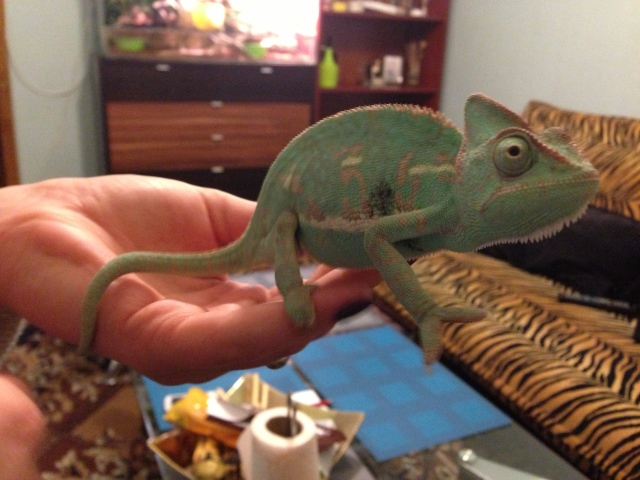 chameleon has developed a black spot on its side
Question
Black spot Black spot close up
sp
chameleon has developed a black spot on its side
Question
Black spot Black spot close up
sp
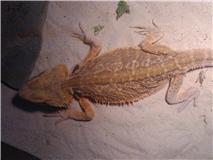 sick
Questionsick lizard
QUESTION: Diane-
I have a t
sick
Questionsick lizard
QUESTION: Diane-
I have a t
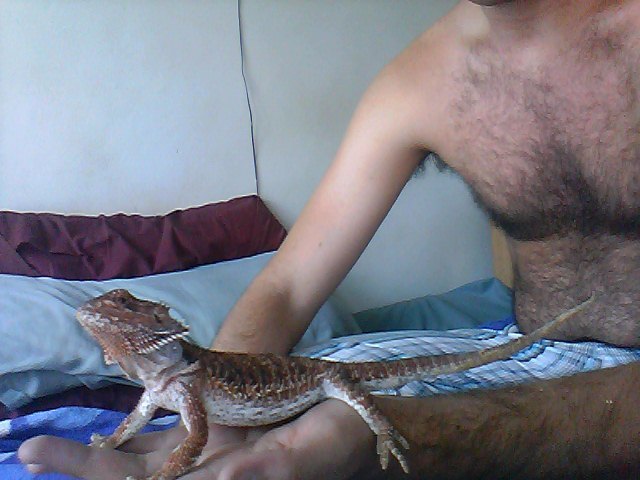 size problem
Question
puff
hey, i have a almost 2 year old fe
size problem
Question
puff
hey, i have a almost 2 year old fe
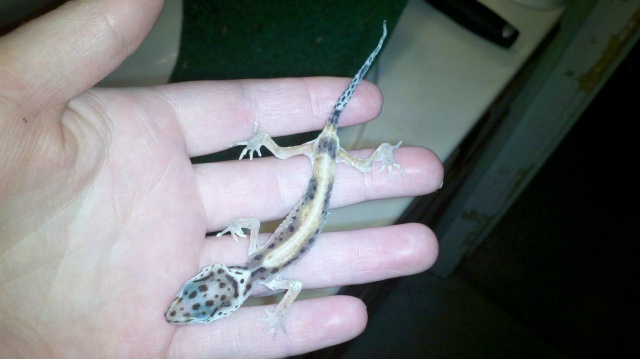 leo weight loss...
Question
Slinkz
My friend has a leopard gecko roughly 3
leo weight loss...
Question
Slinkz
My friend has a leopard gecko roughly 3
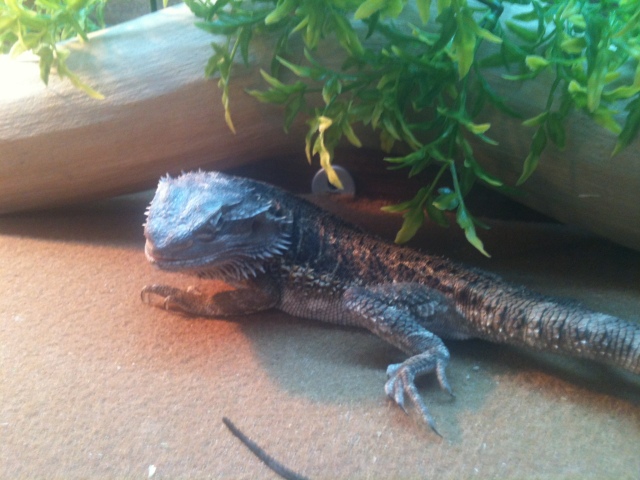 bearded dragon ill
Question
izzy
hi i have ordered a reptisun 10.0
bearded dragon ill
Question
izzy
hi i have ordered a reptisun 10.0